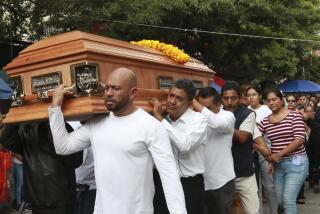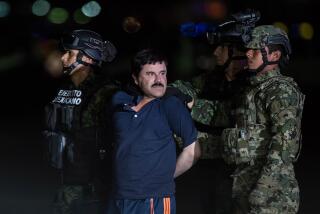Anaysis : Aimed at Forcing Negotiations : Nicaragua’s Border Push Viewed as Calculated Risk
- Share via
MANAGUA, Nicaragua — The Sandinista attack along the Honduran border was a calculated risk aimed at crippling the Contras militarily and forcing them to negotiate an end to their 6-year-old insurgency.
The huge offensive, directed in part at the rebels’ strategic command center and supply depots inside Honduras, was pulled back late last week without reaching those targets after the United States sent more than 3,000 troops to Honduras in a show of force and Honduran warplanes bombed Sandinista targets on both sides of the embattled border.
A Sandinista official said Saturday that the situation was still “highly explosive.” From the start, he said, the army was aware that the offensive could be used to justify a revival of U.S. congressional support for the Contras or direct U.S. military intervention.
But Managua decided to take the risk in the belief that American public opinion would not support either response, the official said. And the Sandinistas saw an opportunity to seize or shut off the main rebel supply center, forcing rebel leaders to the peace table in a weakened state.
“We have always assumed that when the defeat of the Contras came near, we would have to live with the threat of U.S. retaliation,” said the official, who is involved in planning the peace talks. “But we cannot allow that threat to condition our military campaign. We cannot be forced to pull back from our borders and let (the Contras) have a chunk of our territory.”
Just how badly the Contras were hurt by the Sandinistas’ largest offensive of the war could become clearer during three days of cease-fire talks due to start Monday in Sapoa, Nicaragua.
Accounts of the fighting, which raged at least 11 days in a remote, inaccessible jungle on both sides of the border, have been clouded by conflicting claims on both sides.
Sandinista officials admitted privately that at least 1,000 of their troops had crossed the Coco River into Honduras after overrunning Contra bases on the Nicaraguan bank, but they denied U.S. and Honduran claims that the troops had not yet withdrawn.
What appears certain is that while the Sandinistas failed to capture their ultimate targets in Honduras, they have plugged the Contras’ principal route for shipping supplies into Nicaragua and getting hard-pressed troops out.
The nature of the war has changed dramatically in the Sandinistas’ favor this year since Congress defeated two plans, one by the Reagan Administration and one by the Democrats, to renew aid to the Contras.
On March 1, the day after a congressionally mandated end to Contra aid, Washington was forced to halt the CIA supply flights that had picked up ammunition, food and other supplies from an air base on Swan Island, Honduras, and dropped them to rebel units throughout Nicaragua. The Sandinistas’ air defenses had been unable to stop these flights.
What was left of the rebels’ stockpiles, an estimated 300,000 pounds worth, then moved to depots near the command center a few miles from the Nicaraguan border, for delivery by land and river.
The delivery route through the wilds of Nicaragua’s Jinotega province was also being used by depleted Contra units marching out of the country under Sandinista military pressure. Rebel officials say about one-fifth of their army of about 10,000 is in retreat.
The rebels now face the hard choice of turning themselves into a mobile, self-sufficient guerrilla force, something they haven’t yet had to do, or facing Sandinista demands at the peace talks for their virtual surrender.
Rebel Bitterness
“Your (Washington’s) policy put us in this situation,” one Contra official said bitterly. “The Sandinistas want to take us to the negotiations on our knees. They are attacking us where we are weakest.”
Ironically, the rebels’ setback came less than three months after their biggest and most successful offensive of the war, the Christmas week occupation of Nicaragua’s strategic northeastern mining district.
The Sandinista border offensive, launched March 6 with at least 4,500 troops, was essentially a long-planned counterattack in that isolated region. Its rear command base was in Bonanza, one of the three mining towns that had been seized by the Contras.
Then, two days before cease-fire talks were to start March 10, Contra leaders announced they were not ready. The Sandinistas took this to mean that the Reagan Administration was pressing the Contras to avoid a peaceful settlement.
Paul S. Reichler, an American lawyer who is part of the Sandinista negotiating team, said last week that the Nicaraguan army had been prepared to halt the offensive if the peace talks had been held that week and made progress.
After the dimension of the military offensive became clear, Contra leaders agreed to talk, and the negotiations were rescheduled.
Tangible Results
“This confirmed the Sandinistas’ conviction that military pressure is essential to get the talks to succeed,” Reichler said. “The Sandinista pressure is eroding the Administration’s control over them, because Reagan is unable to deliver them any aid.”
The peace talks and the U.S. aid cutoff are the most tangible results of the Central American peace agreement signed last August by the five Central American presidents. It called for restoration of democratic freedoms and an end to outside aid and to sanctuary for rebel forces in the region’s guerrilla conflicts.
In complying with the plan, Nicaragua’s Sandinista rulers skillfully managed a limited political opening in their revolutionary one-party state to persuade the U.S. Congress to believe they were interested in peace. They lifted a state of emergency, restored press freedom and opened peace talks with the Contras.
But the Sandinistas have remained unyielding with both the Contras and unarmed foes who question the legitimacy of their rule. Calling the opposition parties counterrevolutionary agents, the government has cracked down on their rallies and jailed some of their leaders.
Rebel leaders say they will insist in the peace talks on significant political concessions, such as amnesty for all political prisoners and a loosening of Sandinista party control over the army.
Four previous rounds of peace talks have failed to achieve progress because the government insists on discussing only the logistical details of a cease-fire. President Daniel Ortega tried Saturday to keep this week’s talks focused on military issues by reviving a political dialogue with 14 opposition parties that support the Contras’ demands.
Throughout the difficult maneuvering, Ortega has had to explain every concession to members of his party, many of whom seem more militant and hard-line than the nine comandantes who have led the movement since it came to power nine years ago in a guerrilla insurrection.
The internal crackdowns and recent military offensive are strongly supported in the party ranks, who were mobilized last week for standby call-up to the military reserves and to several large rallies condemning the U.S. military response in Honduras.
Thus, Ortega was able to ignore criticism of the Nicaraguan offensive by President Oscar Arias Sanchez of Costa Rica, architect of the peace accord. Arias said the Sandinistas were more intent on destroying the Contras than negotiating with them.
More to Read
Sign up for Essential California
The most important California stories and recommendations in your inbox every morning.
You may occasionally receive promotional content from the Los Angeles Times.










